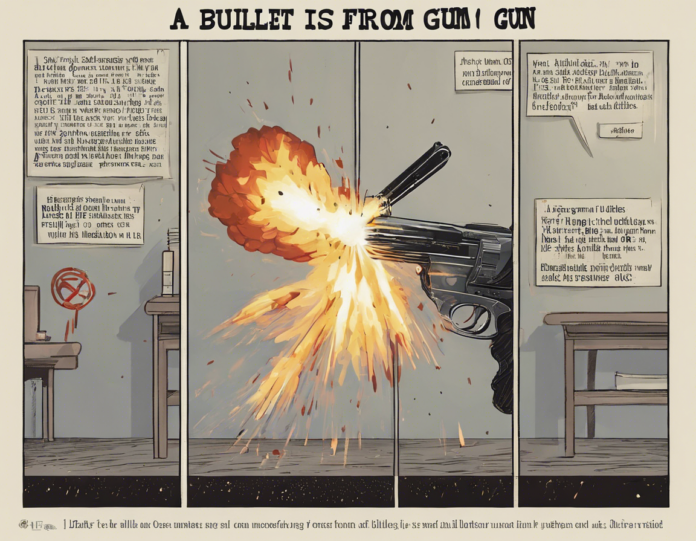Fired Bullet: Deadly Speed In A Single Shot
When we think of firearms, the image of a speeding bullet is often what comes to mind. The sheer speed at which a bullet travels and the damage it can cause in a single shot is both fascinating and terrifying. Let’s delve into the world of bullets, exploring their deadly speed, impact, and the science behind their trajectory.
The Basics of a Bullet
Before we delve into the speed of a bullet, let’s understand its basic components. A bullet is a projectile expelled from a firearm, typically consisting of a casing, gunpowder, a primer, and the projectile itself. The speed at which a bullet travels depends on various factors, including the type of firearm, the caliber of the bullet, the amount of gunpowder, and the muzzle velocity.
The Need for Speed: How Fast Does a Bullet Travel?
The speed of a bullet is commonly referred to as its muzzle velocity, which is the speed at which it exits the barrel of a firearm. Muzzle velocity is measured in feet per second (fps) or meters per second (m/s). Different types of firearms and bullets can achieve varying muzzle velocities.
-
Handguns: Handguns typically have lower muzzle velocities compared to rifles. A typical handgun may have a muzzle velocity ranging from 800 fps to 1500 fps, depending on the caliber and type of bullet.
-
Rifles: Rifles are known for their higher muzzle velocities. For example, a typical rifle bullet may have a muzzle velocity ranging from 2500 fps to 4000 fps, with some high-powered rifles even exceeding 4000 fps.
-
Shotguns: Shotguns fire bullets known as shot shells, which contain multiple pellets. The speed of these pellets can vary widely, with velocities ranging from 1000 fps to 1800 fps.
Impact of Speed on Lethality
The speed of a bullet plays a crucial role in its lethality. When a bullet strikes a target, its speed determines the amount of energy it transfers upon impact. The kinetic energy of a bullet increases with the square of its velocity, meaning that even small increases in speed can significantly enhance its destructive potential.
-
Wound Cavity: The speed of a bullet affects the size and severity of the wound cavity it creates upon impact. A faster-moving bullet tends to create a larger temporary cavity within the tissue, causing more damage along its path.
-
Penetration: Speed also influences the bullet‘s ability to penetrate through various materials. Higher-speed bullets are more likely to penetrate deeply into the target, potentially reaching vital organs and causing more damage.
The Science Behind Bullet Trajectory
In addition to speed, the trajectory of a bullet is influenced by factors such as gravity, air resistance, and the bullet‘s shape and weight. Understanding the science behind bullet trajectory is crucial for marksmen and firearm enthusiasts.
-
Gravity: Gravity pulls a bullet downward as soon as it exits the barrel of a firearm. This downward force causes the bullet to follow a curved trajectory towards the target.
-
Air Resistance: Air resistance, also known as drag, slows down a bullet as it travels through the air. This resistance can cause the bullet to lose speed and drop more quickly over distance.
-
Windage: Wind can also affect a bullet‘s trajectory, especially over long distances. Crosswinds can push a bullet off course, requiring shooters to compensate by adjusting their aim.
FAQs:
1. How fast can a bullet travel?
– A: The speed of a bullet can vary depending on the type of firearm and bullet, but velocities can range from hundreds to thousands of feet per second.
2. What factors affect the speed of a bullet?
– A: The speed of a bullet is influenced by factors such as muzzle velocity, firearm type, caliber, gunpowder amount, and air resistance.
3. Why is speed important for the lethality of a bullet?
– A: Speed determines the kinetic energy of a bullet upon impact, affecting its ability to create a wound cavity, penetrate targets, and cause damage.
4. How does bullet trajectory work?
– A: Bullet trajectory is influenced by factors such as gravity, air resistance, and windage, causing the bullet to follow a curved path towards the target.
5. Can wind affect the trajectory of a bullet?
– A: Yes, wind can push a bullet off course, especially over long distances, requiring shooters to adjust their aim to compensate for windage.
In conclusion, the deadly speed of a bullet is a fascinating aspect of firearms that underscores their destructive power. Understanding the importance of speed, trajectory, and impact can provide insights into the mechanics of ballistics and enhance safety measures when handling firearms. The next time you see a speeding bullet in an action movie or on the shooting range, remember the science and force behind that single, deadly shot.


Recent comments